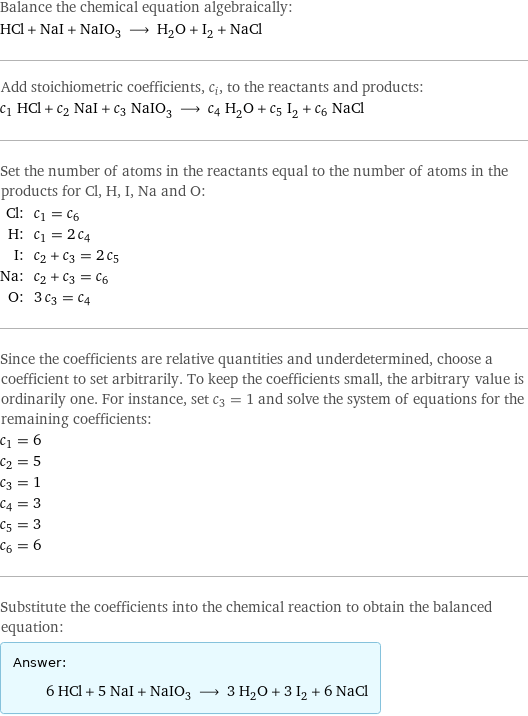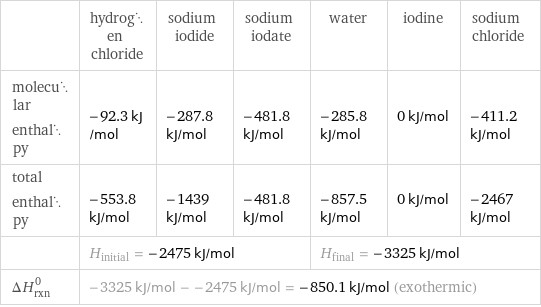Input interpretation

HCl hydrogen chloride + NaI sodium iodide + NaIO_3 sodium iodate ⟶ H_2O water + I_2 iodine + NaCl sodium chloride
Balanced equation

Balance the chemical equation algebraically: HCl + NaI + NaIO_3 ⟶ H_2O + I_2 + NaCl Add stoichiometric coefficients, c_i, to the reactants and products: c_1 HCl + c_2 NaI + c_3 NaIO_3 ⟶ c_4 H_2O + c_5 I_2 + c_6 NaCl Set the number of atoms in the reactants equal to the number of atoms in the products for Cl, H, I, Na and O: Cl: | c_1 = c_6 H: | c_1 = 2 c_4 I: | c_2 + c_3 = 2 c_5 Na: | c_2 + c_3 = c_6 O: | 3 c_3 = c_4 Since the coefficients are relative quantities and underdetermined, choose a coefficient to set arbitrarily. To keep the coefficients small, the arbitrary value is ordinarily one. For instance, set c_3 = 1 and solve the system of equations for the remaining coefficients: c_1 = 6 c_2 = 5 c_3 = 1 c_4 = 3 c_5 = 3 c_6 = 6 Substitute the coefficients into the chemical reaction to obtain the balanced equation: Answer: | | 6 HCl + 5 NaI + NaIO_3 ⟶ 3 H_2O + 3 I_2 + 6 NaCl
Structures

+ + ⟶ + +
Names

hydrogen chloride + sodium iodide + sodium iodate ⟶ water + iodine + sodium chloride
Reaction thermodynamics
Enthalpy

| hydrogen chloride | sodium iodide | sodium iodate | water | iodine | sodium chloride molecular enthalpy | -92.3 kJ/mol | -287.8 kJ/mol | -481.8 kJ/mol | -285.8 kJ/mol | 0 kJ/mol | -411.2 kJ/mol total enthalpy | -553.8 kJ/mol | -1439 kJ/mol | -481.8 kJ/mol | -857.5 kJ/mol | 0 kJ/mol | -2467 kJ/mol | H_initial = -2475 kJ/mol | | | H_final = -3325 kJ/mol | | ΔH_rxn^0 | -3325 kJ/mol - -2475 kJ/mol = -850.1 kJ/mol (exothermic) | | | | |
Equilibrium constant
![Construct the equilibrium constant, K, expression for: HCl + NaI + NaIO_3 ⟶ H_2O + I_2 + NaCl Plan: • Balance the chemical equation. • Determine the stoichiometric numbers. • Assemble the activity expression for each chemical species. • Use the activity expressions to build the equilibrium constant expression. Write the balanced chemical equation: 6 HCl + 5 NaI + NaIO_3 ⟶ 3 H_2O + 3 I_2 + 6 NaCl Assign stoichiometric numbers, ν_i, using the stoichiometric coefficients, c_i, from the balanced chemical equation in the following manner: ν_i = -c_i for reactants and ν_i = c_i for products: chemical species | c_i | ν_i HCl | 6 | -6 NaI | 5 | -5 NaIO_3 | 1 | -1 H_2O | 3 | 3 I_2 | 3 | 3 NaCl | 6 | 6 Assemble the activity expressions accounting for the state of matter and ν_i: chemical species | c_i | ν_i | activity expression HCl | 6 | -6 | ([HCl])^(-6) NaI | 5 | -5 | ([NaI])^(-5) NaIO_3 | 1 | -1 | ([NaIO3])^(-1) H_2O | 3 | 3 | ([H2O])^3 I_2 | 3 | 3 | ([I2])^3 NaCl | 6 | 6 | ([NaCl])^6 The equilibrium constant symbol in the concentration basis is: K_c Mulitply the activity expressions to arrive at the K_c expression: Answer: | | K_c = ([HCl])^(-6) ([NaI])^(-5) ([NaIO3])^(-1) ([H2O])^3 ([I2])^3 ([NaCl])^6 = (([H2O])^3 ([I2])^3 ([NaCl])^6)/(([HCl])^6 ([NaI])^5 [NaIO3])](../image_source/853d07f0606fb533f922df75c09b9625.png)
Construct the equilibrium constant, K, expression for: HCl + NaI + NaIO_3 ⟶ H_2O + I_2 + NaCl Plan: • Balance the chemical equation. • Determine the stoichiometric numbers. • Assemble the activity expression for each chemical species. • Use the activity expressions to build the equilibrium constant expression. Write the balanced chemical equation: 6 HCl + 5 NaI + NaIO_3 ⟶ 3 H_2O + 3 I_2 + 6 NaCl Assign stoichiometric numbers, ν_i, using the stoichiometric coefficients, c_i, from the balanced chemical equation in the following manner: ν_i = -c_i for reactants and ν_i = c_i for products: chemical species | c_i | ν_i HCl | 6 | -6 NaI | 5 | -5 NaIO_3 | 1 | -1 H_2O | 3 | 3 I_2 | 3 | 3 NaCl | 6 | 6 Assemble the activity expressions accounting for the state of matter and ν_i: chemical species | c_i | ν_i | activity expression HCl | 6 | -6 | ([HCl])^(-6) NaI | 5 | -5 | ([NaI])^(-5) NaIO_3 | 1 | -1 | ([NaIO3])^(-1) H_2O | 3 | 3 | ([H2O])^3 I_2 | 3 | 3 | ([I2])^3 NaCl | 6 | 6 | ([NaCl])^6 The equilibrium constant symbol in the concentration basis is: K_c Mulitply the activity expressions to arrive at the K_c expression: Answer: | | K_c = ([HCl])^(-6) ([NaI])^(-5) ([NaIO3])^(-1) ([H2O])^3 ([I2])^3 ([NaCl])^6 = (([H2O])^3 ([I2])^3 ([NaCl])^6)/(([HCl])^6 ([NaI])^5 [NaIO3])
Rate of reaction
![Construct the rate of reaction expression for: HCl + NaI + NaIO_3 ⟶ H_2O + I_2 + NaCl Plan: • Balance the chemical equation. • Determine the stoichiometric numbers. • Assemble the rate term for each chemical species. • Write the rate of reaction expression. Write the balanced chemical equation: 6 HCl + 5 NaI + NaIO_3 ⟶ 3 H_2O + 3 I_2 + 6 NaCl Assign stoichiometric numbers, ν_i, using the stoichiometric coefficients, c_i, from the balanced chemical equation in the following manner: ν_i = -c_i for reactants and ν_i = c_i for products: chemical species | c_i | ν_i HCl | 6 | -6 NaI | 5 | -5 NaIO_3 | 1 | -1 H_2O | 3 | 3 I_2 | 3 | 3 NaCl | 6 | 6 The rate term for each chemical species, B_i, is 1/ν_i(Δ[B_i])/(Δt) where [B_i] is the amount concentration and t is time: chemical species | c_i | ν_i | rate term HCl | 6 | -6 | -1/6 (Δ[HCl])/(Δt) NaI | 5 | -5 | -1/5 (Δ[NaI])/(Δt) NaIO_3 | 1 | -1 | -(Δ[NaIO3])/(Δt) H_2O | 3 | 3 | 1/3 (Δ[H2O])/(Δt) I_2 | 3 | 3 | 1/3 (Δ[I2])/(Δt) NaCl | 6 | 6 | 1/6 (Δ[NaCl])/(Δt) (for infinitesimal rate of change, replace Δ with d) Set the rate terms equal to each other to arrive at the rate expression: Answer: | | rate = -1/6 (Δ[HCl])/(Δt) = -1/5 (Δ[NaI])/(Δt) = -(Δ[NaIO3])/(Δt) = 1/3 (Δ[H2O])/(Δt) = 1/3 (Δ[I2])/(Δt) = 1/6 (Δ[NaCl])/(Δt) (assuming constant volume and no accumulation of intermediates or side products)](../image_source/19898b60fab25737cc0e8661b781cfa9.png)
Construct the rate of reaction expression for: HCl + NaI + NaIO_3 ⟶ H_2O + I_2 + NaCl Plan: • Balance the chemical equation. • Determine the stoichiometric numbers. • Assemble the rate term for each chemical species. • Write the rate of reaction expression. Write the balanced chemical equation: 6 HCl + 5 NaI + NaIO_3 ⟶ 3 H_2O + 3 I_2 + 6 NaCl Assign stoichiometric numbers, ν_i, using the stoichiometric coefficients, c_i, from the balanced chemical equation in the following manner: ν_i = -c_i for reactants and ν_i = c_i for products: chemical species | c_i | ν_i HCl | 6 | -6 NaI | 5 | -5 NaIO_3 | 1 | -1 H_2O | 3 | 3 I_2 | 3 | 3 NaCl | 6 | 6 The rate term for each chemical species, B_i, is 1/ν_i(Δ[B_i])/(Δt) where [B_i] is the amount concentration and t is time: chemical species | c_i | ν_i | rate term HCl | 6 | -6 | -1/6 (Δ[HCl])/(Δt) NaI | 5 | -5 | -1/5 (Δ[NaI])/(Δt) NaIO_3 | 1 | -1 | -(Δ[NaIO3])/(Δt) H_2O | 3 | 3 | 1/3 (Δ[H2O])/(Δt) I_2 | 3 | 3 | 1/3 (Δ[I2])/(Δt) NaCl | 6 | 6 | 1/6 (Δ[NaCl])/(Δt) (for infinitesimal rate of change, replace Δ with d) Set the rate terms equal to each other to arrive at the rate expression: Answer: | | rate = -1/6 (Δ[HCl])/(Δt) = -1/5 (Δ[NaI])/(Δt) = -(Δ[NaIO3])/(Δt) = 1/3 (Δ[H2O])/(Δt) = 1/3 (Δ[I2])/(Δt) = 1/6 (Δ[NaCl])/(Δt) (assuming constant volume and no accumulation of intermediates or side products)
Chemical names and formulas

| hydrogen chloride | sodium iodide | sodium iodate | water | iodine | sodium chloride formula | HCl | NaI | NaIO_3 | H_2O | I_2 | NaCl Hill formula | ClH | INa | INaO_3 | H_2O | I_2 | ClNa name | hydrogen chloride | sodium iodide | sodium iodate | water | iodine | sodium chloride IUPAC name | hydrogen chloride | sodium iodide | sodium iodate | water | molecular iodine | sodium chloride